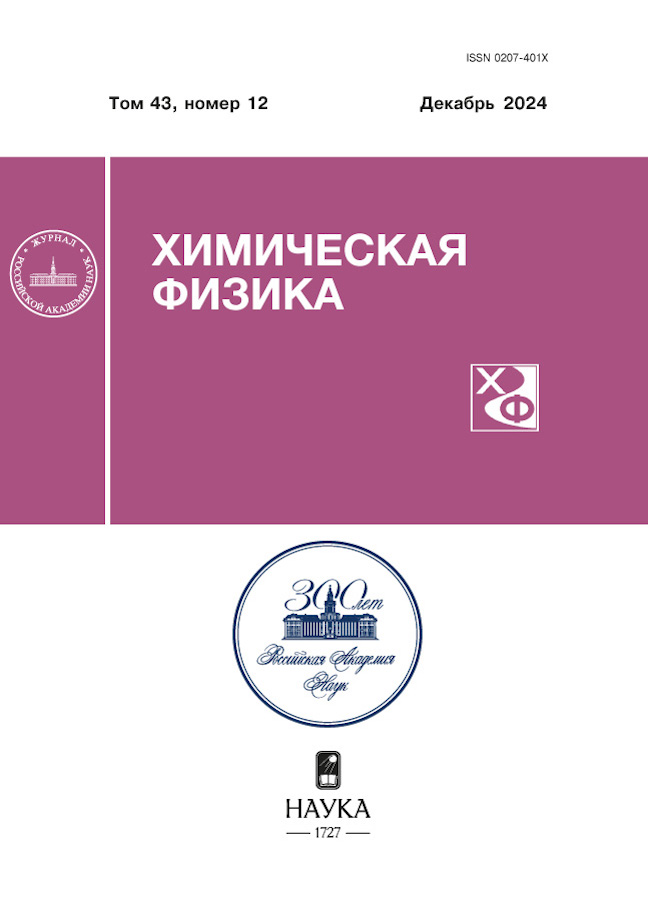The manifestation of spin-selectivity of the singlet exciton decay into a pair of triplets in the kinetics of the exciton decay in rubrene films
- Autores: Shushin A.I.1, Umanskii S.Y.1
-
Afiliações:
- Semenov Federal Research Center for Chemical Physics, Russian Academy of Sciences
- Edição: Volume 43, Nº 12 (2024)
- Páginas: 106-112
- Seção: Chemical physics of nanomaterials
- URL: https://archivog.com/0207-401X/article/view/684182
- DOI: https://doi.org/10.31857/S0207401X24120106
- ID: 684182
Citar
Texto integral
Resumo
The kinetics of singlet fission (SF) (i.e. spontaneous splitting of the excited singlet state into a pair of triplet (T) excitons (TT-pair)) is known to be be essentially affected by TT-annihilation (TTA), which manifests in magnetic field effects on the TTA and, in particular, in the magnetic-field dependence of the SF-kinetics. In this work, within the two-state model (TSM), the method of treating the magnetic field effects on the SF-kinetics, which allows for the correct description of the manifestation of stochastic migration of Texcitons assuming that the manifestation results from transition from two states of coupled and freely diffusing T-excitons. Within the TSM the analytical expression for the magnetic-field-dependent part of the SF-kinetics is derived. This expression is applied to the analysis of the SF-kinetic measured in amorphous rubrene films in the absence magnetic field and in the field B = 8 kGs.
Palavras-chave
Texto integral
Sobre autores
A. Shushin
Semenov Federal Research Center for Chemical Physics, Russian Academy of Sciences
Autor responsável pela correspondência
Email: shushin@chph.ras.ru
Rússia, Moscow
S. Umanskii
Semenov Federal Research Center for Chemical Physics, Russian Academy of Sciences
Email: shushin@chph.ras.ru
Rússia, Moscow
Bibliografia
- M.B. Smith, J. Michl, Annu. Rev. Phys. Chem. 64, 361 (2013). https://doi.org/10.1146/annurev-physchem-040412-110130
- D. Casanova, Chem. Rev. 118, 7164 (2018). https://doi.org/10.1021/acs.chemrev.7b00601
- K. Miyata, F.S. Conrad-Burton, F. L. Geyer et al., Chem. Rev. 119, 4261 (2019). https://doi.org/10.1021/acs.chemrev.8b00572
- R.E. Merrifield. J. Chem. Phys. 48, 4318 (1968). https://doi.org/10.1063/1.1669777
- A. Suna, Phys. Rev. B 1, 1716 (1970). https://doi.org/10.1103/PhysRevB.1.1716
- A.I. Shushin, J. Chem. Phys., 156, 074703 (2022). https://doi.org/10.1063/5.0078158
- V.V. Tarasov, G.E. Zoriniants, A.I. Shushin et al. Chem. Phys. Lett. 267, 58 (1997). https://doi.org/10.1016/S0009-2614(97)00056-0
- A.S. Vetchinkin, S.Ya. Umanskii, Ju. A. Chaikina et al. Russ. J. Phys. Chem. B. 2022. V. 16, P. 945. https://doi.org/10.1134/S1990793122050104
- A.I. Shushin, S.Y. Umanskii, Y.A. Chaikina. Russ. J. Phys. Chem. B. 2023. V. 17. P. 860. https://doi.org/10.1134/S1990793123040176
- A.I. Shushin, S.Y. Umanskii, Y.A. Chaikina. Russ. J. Phys. Chem. B. 2023. V. 17. P. 1403. https://doi.org/10.1134/S1990793123060210
- S.Y. Umanskii, S.O. Adamson, A.S. Vetchinkin et. al. // Russ. J. Phys. Chem. B. 2023. V. 17. P. 346. https://doi.org/10.1134/S199079312302032X
- A. Ryansnyanskiy, I. Biaggio, Phys. Rev. B 84, 193203 (2011). https://doi.org/10.1103/PhysRevB.84.193203
- T. Barhoumi, J. L. Monge, M. Mejatty et al. Eur. Phys. J. B, 59, 167 (2007).
- G.B. Piland, J.J. Burdett, D. Kurunthu et al. J. Phys. Chem. 117, 1224 (2013). https://doi.org/10.1021/jp309286v
- G.B. Pilland, J. Burdett, R.J. Dillon et al. J. Phys. Chem. Lett. 5, 2312 (2014). https://doi.org/10.1021/jz500676c
- A.I. Shushin, Chem. Phys. Lett. 118, 197 (1985). https://doi.org/10.1016/0009-2614(85)85297-0
- A.I. Shushin, J. Chem. Phys. 95, 3657 (1991). https://doi.org/10.1063/1.460817
- A.I. Shushin, J. Chem. Phys. 97, 1954 (1992). https://doi.org/10.1063/1.463132
- U.E. Steiner, T. Ulrich, Chem. Rev. 89, 514 (1989). https://doi.org/10.1021/cr00091a003
- A.I. Shushin, Chem. Phys. Lett. 678, 283 (2017). https://doi.org/10.1016/j.cplett.2017.04.068
- A.I. Shushin, J. Chem. Phys. 151, 034103 (2019). https://doi.org/10.1063/1.5099667
- K. Blum, Density Matrix Theory and Applications. (Plenum Press, New York, 1981).
Arquivos suplementares











